Exploring the 'Water City' of Suzhou in 1996
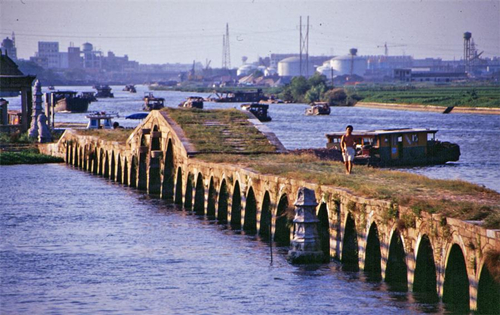
Precious Belt Bridge (Bao Dai Qiao). [Photo by Bruce Connolly/chinadaily.com.cn]
Visiting Shanghai in 1996, I looked down from the Oriental Pearl Television Tower to where Suzhou Creek entered the Huangpu River. So many barges were navigating or berthed along this narrow channel. Intrigued I poured over maps of the lower Yangtze River basin that revealed a dense network of waterways interlacing and connecting with Lake Tai, the Yangtze and the Grand Canal running north from Hangzhou past Suzhou. Indeed the presence of so much water and saturated ground was historically problematic, if not impossible, for conventional road construction. For several millennium waterways were the principal option for travel in much of eastern China. Towns well-connected by water boomed. There were also bountiful harvests of rice and fish.
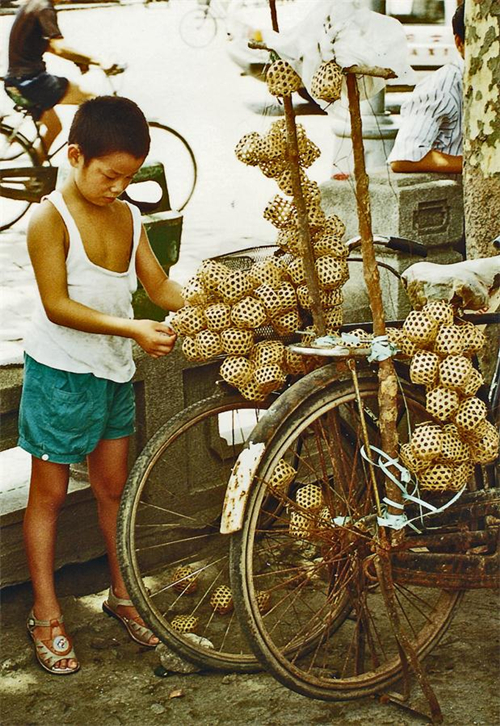
Boy with bamboo cicada boxes Suzhou 1996. [Photo by Bruce Connolly/chinadaily.com.cn]
I came to realize that the section of Suzhou Creek in Shanghai was actually man-made. Much of its course toward Suzhou is known as the Wusong River. Historically it entered the Yangtze almost where the Huangpu today flows into China's "Long River" at the mouth of the Wusong. Silting was a problem. Much of the land is flat, lying just above water level, creating only a slow moving current. In the 16th century this was alleviated by digging a narrower channel, Suzhou Creek, reaching the Huangpu close to Shanghai's Waibaidu Bridge.
I decided to head for Suzhou, one hour inland by train on a line connecting both cities since July 16, 1906. That journey repeatedly emphasized the closeness, this interface between water and the land.
Arriving at the Suzhou Railway Station, I had to insist on being taken to the hotel of my choice and not those favored by taxi drivers! I got my wish and was soon sitting in a ting, or pavilion, overlooking an arched bridge and pond in the garden of a small compound close to the southeastern corner of the former city walls. Suzhou was starting to feel relaxing.
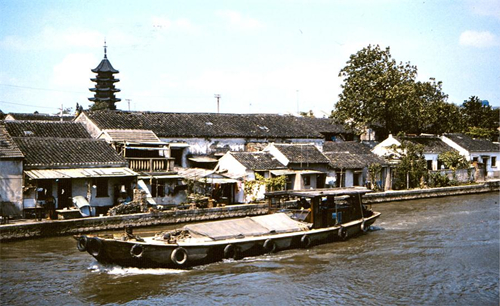
Canal near Ruiguang Pagoda Suzhou 1996. [Photo by Bruce Connolly/chinadaily.com.cn]
Walking around, my first impression was how much quieter Suzhou felt, despite its over 2,500 years of history when compared to the rush and bustle of Shanghai 100 kilometers back down the railway line. One of the oldest cities in the area, Suzhou in 1996 felt like a place where people seemed to have time to talk while restaurants and even the buses were reasonably quiet. However this was not always the case. Around AD 100 during the Eastern Han Dynasty, Suzhou was one of the world's 10 largest cities, totally dwarfing Shanghai, due to migration from northern China, It was famed for its range of the finest Chinese silks and, by the mid-19th century, Chinese language publishing. In recent years it again has grown rapidly into economically one of China's most prosperous cities, becoming a center for many high-tech companies. It ranks amongst the country's top tourist destinations, something I was witnessing in its fledgling days.
Finding a garden restaurant where diners could sit in individual bamboo structures, I had a cold drink while starting to work out a strategy. It was so relaxing and tempting to remain there all day - a recurrent Suzhou theme!
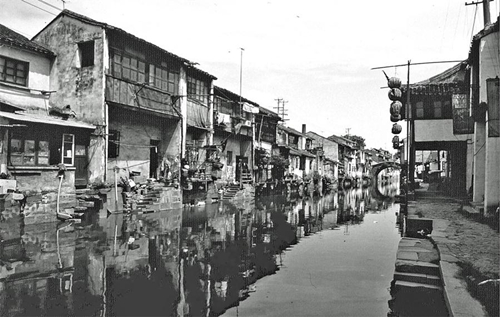
Canal-side homes Suzhou 1996. [Photo by Bruce Connolly/chinadaily.com.cn]
The North Temple Pagoda close to Renmin Road was a good place to start my explorations, particularly after purchasing a city map. With then few tall buildings and Suzhou's mostly level topography, the nine-story and 76-meter-tall Ming Dynasty (1368-1644) tower provided panoramic views across a maze of low-rise rooftops to distant hills. Directly below were some of the exquisite gardens that continue to make Suzhou a prize tourist draw. Of course I visited several, for no visit to the city would be complete without such lovely experiences. They reflected a unique skill in perfecting gardens incorporating water, stone, trees and flowers along with walkways and pavilions overlooking ponds teeming with golden fish, all within tight spaces. But they were also testimony to the wealth of historic Suzhou, for some were once the residences of merchants and officials overseeing the waterborne commerce of this "Venice of the East".
Even within the early 20th century, much of Suzhou's geography consisted of islands connected by a maze of canals and creeks of varying importance that also linked with both the surrounding countryside and the water towns scattered across this vast alluvial basin. So much barge traffic converged on the city, potentially creating a forerunner of today's highway traffic jams!
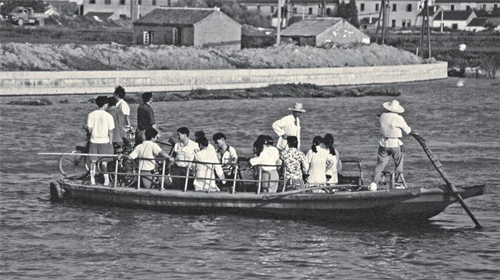
Cross-canal ferry Suzhou 1996. [Photo by Bruce Connolly/chinadaily.com.cn]
The map highlighted what looked an intriguing area at the southwest corner of the former 10-kilometer-long city walls. I headed off following canal banks, passing through what felt like village scenes that had somehow survived the ravages of time.
Eventually I reached Panmen, today a prominent tourist area but in 1996 still fairly rustic, indeed amazingly tranquil. It remains the location of a well-preserved water gate. Spending a few hours there, I was intrigued to examine how water flow was controlled by a sluice system. While most walled Chinese cities were accessed by conventional gates, this one opened to allow navigation from the canals. A main access point into Suzhou, it was consequently strongly built and defended. Originating from the Wu kingdom of the Spring and Autumn period (770 to 476 BC), it is topped by a tower rebuilt in1986 to commemorate 2,500 years of Suzhou's history.
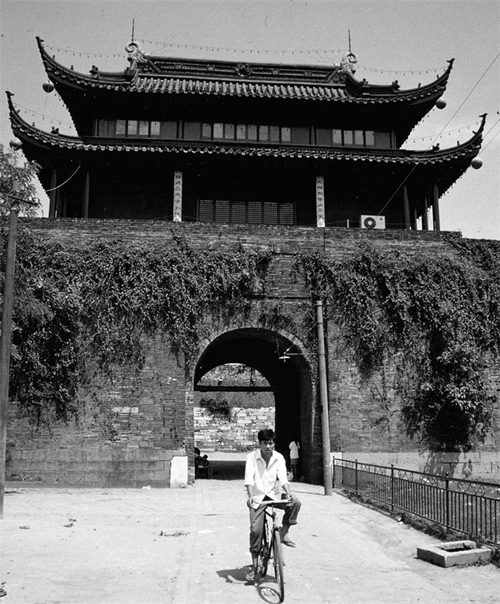
Cyclist at water gate Panmen Suzhou 1996. [Photo by Bruce Connolly/chinadaily.com.cn]
The nearby arched 11-meter-high Wumen Bridge spanning the Waicheng River provided excellent views not just of the surrounding history but also of passing river traffic. Fifty steps led up each side of this almost thousand-year-old structure, the highest ancient bridge remaining in Suzhou. The scene was enhanced by the eight-sided, seven-floor Ruigang Pagoda rising 53.6 meters above Panmen, for centuries an iconic symbol of the city. Though considerably restored over time, it originated during the Three Kingdoms Period (220-280) when King Sun Quan of the Wu ordered its construction as a gesture of respect to his mother.
As always, during my time in Suzhou, waterway activities kept me focused. Boats were frequently temporary homes for entire families of canal people. Pot plants decorated the wheelhouses, cooking equipment stacked beside small kitchens. Many barges carried bicycles.
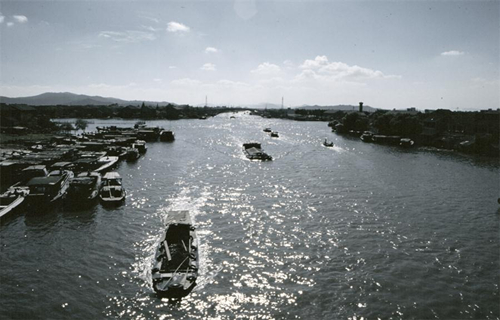
Grand Canal near Suzhou 1996. [Photo by Bruce Connolly/chinadaily.com.cn]
I became a regular at a cafe near my hotel. When the owner learned of my passion for the waterways, she inquired if I had been to the Baodai Bridge? Although located beyond the old walled city, it should have been reasonably simple to find, but new residential areas were rising alongside rice fields and former rural villages. Suzhou was expanding, I wandered around disoriented! Spotted by an agricultural scientist, he invited me for lunch with his colleagues. A route was then described to an intersection between the wide Grand Canal and Dantai Lake where the bridge connected to an island.
At 317 meters long with 53 arches, Baodai Bridge dates back to 816 during the mid-Tang Dynasty (618-907). The name, which means "precious belt" in Chinese, apparently came from a local prefect Wang Zhongshu who sold his precious belt to finance the construction. The current structure supposedly resembling "a jade belt floating in water" was erected in 1446 during the Ming Dynasty. Again, it was an excellent vantage point to observe the river along with modern industry spreading along the banks. In historic times it was a place of serenity with distant mountains, fertile fields and water seemingly everywhere.
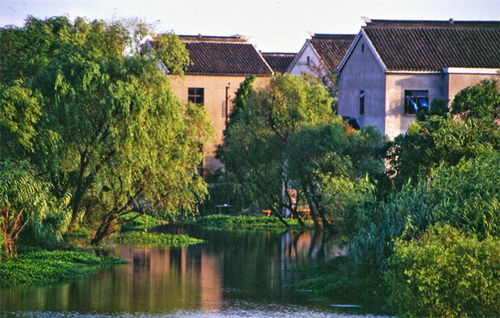
Land and water very close around Suzhou 1996. [Photo by Bruce Connolly/chinadaily.com.cn]
Qing Dynasty poet Lu Shiyi was inspired to write:
"The water of Dantai Lake is shiny green
The Baodai Bridge floats like a silken ribbon
If possible I would plant groves of peaches
And then enjoy every spring amid the flowers"
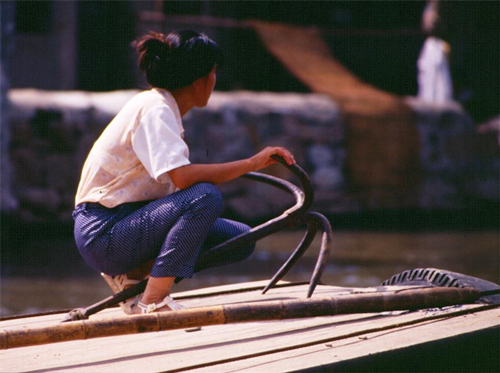
Navigating a Suzhou canal 1996. [Photo by Bruce Connolly/chinadaily.com.cn]
Traveling by city bus, I constantly watched for potentially interesting areas to jump off at or return later. That way I discovered narrow canals with buildings constructed over stone-paved walkways providing shelter from sun or rain. At that time not much had been modernized, the semirundown appearance creating excellent locations for artists, photographers or film sets. Where there were arched bridges, groups of people would gather to play cards, board games or have impromptu musical concerts. These were living communities where the sound and aroma of stir-fried cooking filled the air while fresh noodles dried outside. Clothes hung from small verandahs alongside bird cages protruding from windows.
The waterways were closely tied with local life. At canal intersections I sat on walls watching melons carted up from small wooden boats to be sold directly to pedestrians or cyclists crossing the often congested bridges - not congested by cars but by a constant human flow. There were surviving sections of the former city walls - some acting as arched gateways across the streets.
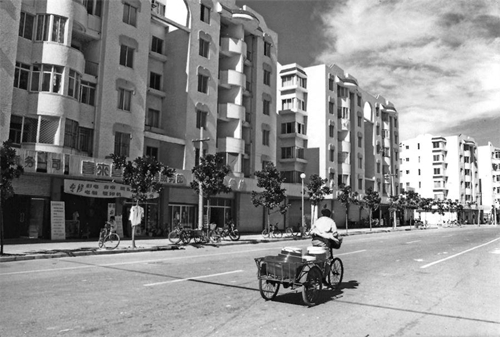
New apartments in suburban Suzhou 1996. [Photo by Bruce Connolly/chinadaily.com.cn]
Sometimes boats were so heavily laden that their decks were just above the water. Along busy channels, care was taken with passage particularly at narrow bridges where an orderly "right-of-passage" was observed. Lookouts sat at frontal bows signaling with flags to their wheelmen if it was safe to pass through. Barges often lined up in a convoy, moving slowly through congested areas. In the midst of this two men paddled small boats.
Suzhou's canals remain busy thoroughfares but some, due to their charm and potential, have been smartened up into popular tourist areas, allowing visitors to relax at waterside cafes or restaurants while taking in the scene. Wooden barges carry tourists pass smart hotels converted from former canal-side dwellings.
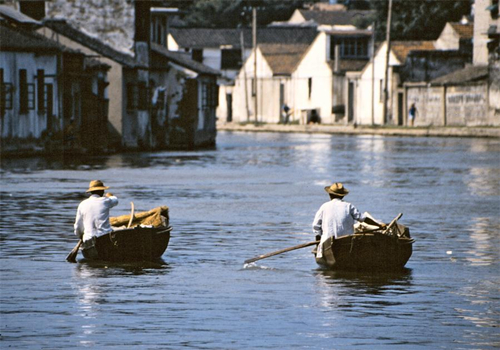
Paddling along a Suzhou canal 1996. [Photo by Bruce Connolly/chinadaily.com.cn]
The area's man-water relationship going back well over 2,000 years was a daily fascination for me. I originally planned on a couple of days in Suzhou but ended up staying a week, for Lake Tai was beckoning.
Obviously I have described a unique city as it was in 1996. Suzhou has changed, just as China has rapidly moved forward over the past two decades. It will be fascinating to return in spring 2018 and revisit the locations 22 years later!
The author is senior blogger of China Daily website.
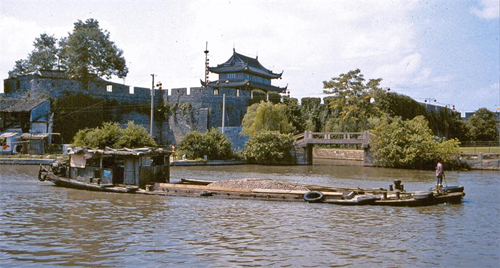
Panmen Water Gate Suzhou 1996. [Photo by Bruce Connolly/chinadaily.com.cn]
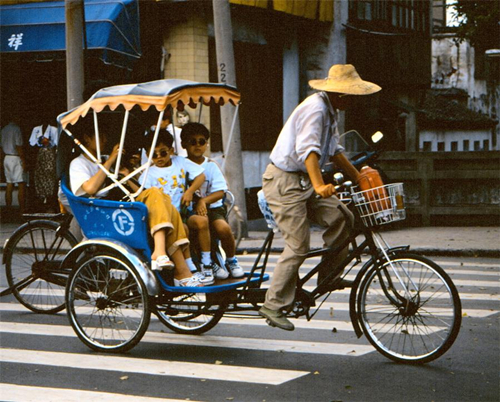
Pedicab on a Suzhou street 1996. [Photo by Bruce Connolly/chinadaily.com.cn]
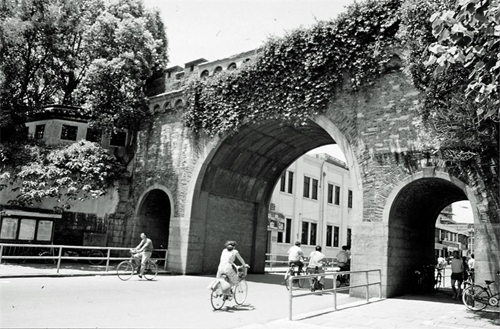
Remains of old city wall Suzhou 1996. [Photo by Bruce Connolly/chinadaily.com.cn]
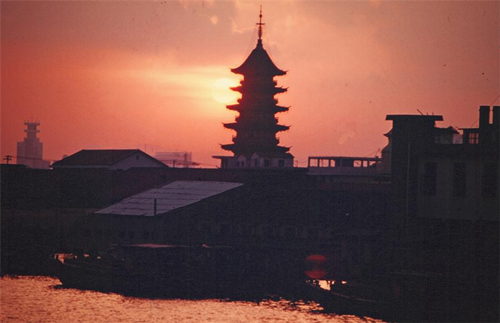
Ruiguang Pagoda Panmen Suzhou 1996. [Photo by Bruce Connolly/chinadaily.com.cn]
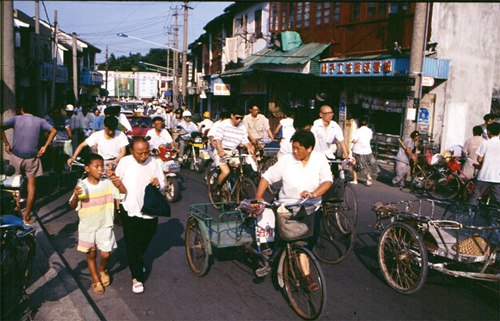
Street scene in older area of Suzhou 1996. [Photo by Bruce Connolly/chinadaily.com.cn]
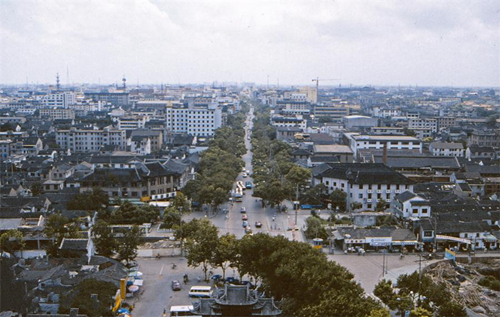
Suzhou from North Temple Pagoda 1996. [Photo by Bruce Connolly/chinadaily.com.cn]
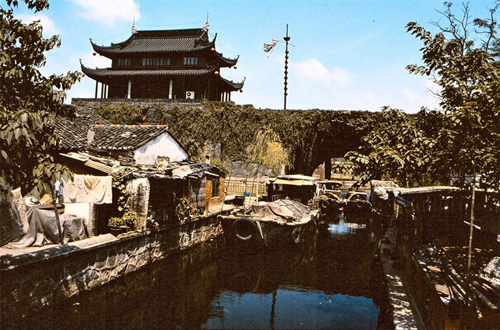
Water gate at Panmen Suzhou 1996. [Photo by Bruce Connolly/chinadaily.com.cn]
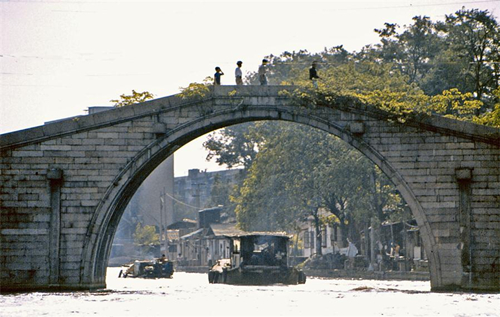
Wumen Bridge Suzhou 1996. [Photo by Bruce Connolly/chinadaily.com.cn]
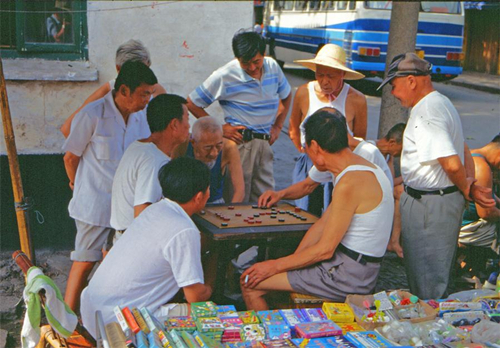
Afternoon canal-side activities Suzhou 1996. [Photo by Bruce Connolly/chinadaily.com.cn]








